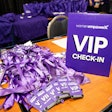
Every successful event begins with a clear, compelling mission statement. This foundational piece not only articulates the purpose of your gathering, but also acts as a north star for all planning decisions. Clearly defining the "why" behind your event helps you align your team, attract the right audience, and enhance every aspect of the experience.
“Events are not held just to be held—there is always a purpose,” points out Melissa Johnson, vice president of Cameron Mitchell Premier Events in Columbus, Ohio. “The event mission is our guiding filter that will be revisited together often during planning to ensure we stay on target together."
We asked Johnson and other event profs how they approach this process.
1. Start these conversations right away.
From the very first discovery call, it's crucial to define the core values the event should embody, as well as the target audience and the outcomes the client is hoping to achieve. “This needs to be the first thing you do when planning an event,” advises Nicole LaPointe, founder and CEO of Detroit-based corporate events agency GatherPointe. “Why are you hosting it? Who will attend? What outcome do you want to achieve from the event? When an idea for an event is created, that is when the process for the 'why' is decided.”Jason Konopinski, marketing manager for Lancaster, Penn.-based event production company Shumaker PDT, agrees. “Clearly understanding—and defining—the ‘why’ of an event begins from our initial discovery meetings to ensure that our teams are in complete alignment,” he says.
2. Be prepared with a list of questions.
Thien-Nga Palmer, CEO and founder of T Palmer Agency and JET The Agency, likes to be prepared with a set list of questions that will help her define this “why" right away. “Is it the experience and ‘wow factor’ that are more important to the company, conference, or brand? Is it more about networking? Or, is it simply about having an event for no other reason than to stay on people’s radars?” she asks. “Then, I want to understand if we are trying to create something that we can build on from year to year and continuously elevate, or is this a one-time thing? All of this will impact the strategy."LaPointe formalizes the process with an intake form that she sends clients as soon as her event agency is hired. The form "helps clients clearly define why they are doing the event and what goals they want to achieve," she explains. "This is the basis for marketing and costs. This even helps with where the event might be and what speakers to bring on board."
3. Actively listen, and don’t insert your own assumptions.
Johnson stresses the importance of asking the right questions and then actively listening—and asking follow-up questions as needed. “While this sounds relatively easy, it is surprising how so many stop listening, add their own inferences and preferences, or fail to grasp the vision being described," she says. "As an event planner, you are not designing your own event. You are designing an event for someone else, thus it is very important to understand their why.”Johnson outlines three main questions that help her with this process.
Why are they planning this event? “What are the main priorities for them/their organization?” Johnson asks. “Help the conversation along by asking about goals such as fundraising, social engagement and awareness, community, recognition, continued education, or networking.”
What does success look like for them? “I ask if their organization has a mission statement and set of guiding principles," she adds. "Knowing who the organization is and what they stand for will help as we plan the experience for their guests and meet the desired outcome.”
Who is their target audience? “It is important to know demographic information in a generalized sense to understand if there is a majority age range, activity level, or any information that will help take care of the invited guests in the best way,” she advises.
4. Consider whether the event calls for one overarching goal, or multiple.
Yes, it's OK to have multiple goals for an event! "If the goal is to educate the public and make money, those two goals can be achieved simultaneously—but the goals need to complement each other. They can't oppose each other," explains LaPointe. "Most event goals fit together. Education and networking and making it a revenue-generating event are all goals that go together."Remember that the process of defining goals can change depending on the type of event being planned. “For social events, defining single goals is much easier—creating lasting family memories made all the more poignant through the use of lighting and decor [for example],” points out Konopinski. “For community impact organizations and corporate events, multiple goals are more likely. An event can be part of a larger capital campaign, having both direct appeals and celebration wrapped into one package.”
5. Understand that key stakeholders might have differing goals.
“Often there is a committee or multiple chairs of an event—and when having the initial meeting there may be differences of vision and mission," says Johnson. "It is important to have them prioritize these so that more than one goal may be accomplished at the event. Knowing how their goals are prioritized helps the design and production of the flow in an organized manner that will be used as a filter during the planning process."In situations where different stakeholders have differing visions, Konopinski stresses the importance of clear communication. “This is the perfect opportunity for brass tacks conversations with the client, especially if there is a planning committee steering both budget and design,” he says. “It is important to acknowledge the needs and concerns of every stakeholder while working toward meeting the vision of the event, which can look like, ‘I hear you, and…’ From that point forward, as professionals and the acknowledged experts, keep each concern top of mind while working to meet the goals set by the stakeholders.”
6. Put it in writing.
Taylor Buonocore-Guthrie, the keynote speaker and event facilitator behind The Connection Spark, suggests writing down a clear mission statement. "First of all, it helps with alignment, especially when there are multiple stakeholders involved," she explains. "When you simply reference a bullet-pointed list rather than a clear 'Purpose Statement,' it's easy to get lost in the purpose."Ideally, this is written as a single sentence, she adds. "You can use the following format as a starting point: '[Audience] are gathering together to [describe the impact of the event] for the [relevant time frame],'" she suggests—noting that the statement should be highly unique to each event.
Buonocore-Guthrie shared some examples to illustrate this formatting:
- "A group of global leaders will develop guiding principles for a new initiative to target climate change between 2025-2035."
- "The marketing team will launch an AI-powered experiential booth at [event name here], with the goal of engaging 500+ users in five days."
- "The executive team will identify the shifts that are needed to reach the next stage of growth, and individually commit to three actions within the next six months."
7. Keep the “why” at the forefront of your decision-making throughout the entire planning process.
A mission statement is more than just a few lines about your event; it's the foundation upon which every decision should be based—from the choice of venue to the selection of speakers to the design of promotional materials. It helps ensure consistency and clarity in your event's branding, messaging, and objectives, which is essential for attracting the right attendees, sponsors, and media attention. “The singular ‘why’ affects and informs all future decisions, so it’s especially important to ensure everything connects back,” sums up Konopinski. “A designed atmosphere and aesthetic supports the 'why' rather than standing at odds.”Palmer likes to visualize the "why" as the top of a pyramid. "Each subcategory of planning all leads back to that initial 'why'—it creates the theme, the mood, the decor, the venue, the menu selection, and depicts the overall journey of what we are trying to accomplish with the event," she says. "Whether it’s a travel destination for the top sales reps or a closing event to a client summit, our goal is that every guest in attendance understands why they are there for the event. And, if it goes the way we plan, it’s an event that leaves an impact they’ll remember.”



















